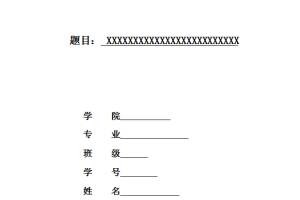摘 要
近几年来,随着移动互联网的普及和发展,共享经济已经成为促进国内GDP增长的新模式。从最开始的房宿、车座共享,逐步转向分享人的技能知识,越来越多提供分享经济的平台涉入,其规模逐步扩大。这种方式将所有权和使用权分离出来,可以说是创造了消费领域的新模式,给社会带来了巨大的共有福利和资源效益。
作为最早涉足共享经济的优步自2014年进入中国以来到2016年8月优步中国被滴滴收购合并,一直备受关注。自此优步中国却不再被人瞩目。然而,风雨洗礼之后的优步中国保持独立运营,该如何应对变幻莫测的市场竞争?
本文以优步青岛为研究对象,从地区入手,结合区域特征,通过PEST、五力模型和道斯矩阵,分析得出优步青岛所面临的外部环境中存在:
机会——共享经济理念为政府和社会公众所接受;青岛拥堵情况严重;打车习惯养成,民众对出行质量的要求提高;网络约车的技术环境成熟,信任度高;
威胁——网约车细则的颁布大大提高私家车准入标准,可用车辆数量骤减,导致市民打车困难,价格高,继而转投出租车;青岛大力发展公共交通,未来铺设的十几条地铁线路将极大冲击网络专车的出行市场份额;
通过优势劣势分析发现优步青岛的内部环境存在的优势:UBER文化的积淀形成一定的忠诚用户基础;本地营销合作资源充足,具有合作基础;整合和共享作为滴滴行业老大的资源,更加专注业务与市场开发。
优步青岛的内部环境存在的劣势——业务单一,系统功能不尽如人意;人才匮乏,内部乏力;合并影响,负面报道导致信任危机。
因此,优步青岛的战略目标既要实现外部的品牌升值、市场增长,又要实现内部的盈利目标和组织稳定。据此提出了四大竞争战略建议:(1)坚持差异化战略,深耕品牌价值;(2)目标聚焦战略,精准对点用户;(3)识别动态能力,构建战略优势;(4)集中整合资源,实现合作竞争。并通过产品创新、营销升级、集成管理和规范服务四各方面来保障实施,从人才、信用体系和资金储备三个角度来进行战略控制。
关键词: 竞争战略;优步青岛;共享经济;网约车市场
Research on Competitive Strategy of UBER Qingdao
Abstract
Recently, the share of economic model has become a new path of economic growth. Starting from the area of the first rental, car rental, and gradually turned to human knowledge and skills sharing, provide economic platform has been gradually expanding. In this way can be said to be creating a new model of consumption, ownership and use of the separated, shared benefits and resources to the community has brought great benefits. As the first step involved in the shared economic since entered China in 2014 to August 2016 step drops merger and acquisition in China has been a cause of concern. Since China is no longer remarkable. However, after the trials and hardships of China operate independently, how to deal with the vagaries of competition?
Paper to excellent step Qingdao for research object, through PEST, and five force model and road matrix, analysis obtained excellent step Qingdao by faced of external environment in the exists:
opportunities–shared economic concept for Government and social public by accept; Qingdao hold blocking situation serious; taxi habits habit, people on travel quality of requirements improve; network about car of technology environment mature, trust degrees high;
threat–network about car rules of issued greatly improve cars access standard, available vehicles number sudden reduction, led to public taxi difficult, price high, Then turned voted taxi; Qingdao vigorously development public traffic, future laying of more than 10 article Metro line will great impact network car of travel market share;
through advantage disadvantage analysis found excellent step Qingdao of internal environment exists of advantage: UBER culture of accumulation formed must of loyalty user based; local marketing cooperation resources sufficient, has cooperation based; integration and shared as drops drop industry boss of resources, more focused business and market development.
Disadvantages of internal environment in Qingdao-business single, system function is not satisfactory; lack of talents, inner weakness; combined effect, negative reports led to a crisis of confidence.
Therefore, the Qingdao strategic objectives as well as implementing an external brand appreciation, market growth and profit target to achieve internal stability and organization. Four competitive strategies accordingly recommended that:
(1) adhere to the differentiation strategy, with roots in brand value, (2) focused strategy, precision to point users and (3) identifying dynamic capability to build a strategic advantage (4) centralized integration of resources to achieve cooperation and competition.
Upgrades, integration and through product innovation, marketing management and standardize the services to guarantee the implementation of all aspects, from human resources, credit system and funding perspectives to strategic control.
Key Words:UBER Qingdao;Competitive Strategy; Share Economy
1 绪论……………………………………………………………………. 1
1.1 研究背景………………………………………………………………………………………………. 1
1.2 研究现状………………………………………………………………………………………………. 1
1.3 研究目的与意义……………………………………………………………………………………. 3
1.4 研究方法与研究框架…………………………………………………………………………….. 3
1.4.1 研究方法………………………………………………………………………………………….. 3
1.4.2 研究框架………………………………………………………………………………………….. 4
2 理论基础…………………………………………………………….. 6
2.1 企业内外部分析……………………………………………………………………………………. 6
2.1.1 PEST分析………………………………………………………………………………………….. 6
2.1.2 SWOT分析………………………………………………………………………………………… 6
2.2 波特竞争五力模型………………………………………………………………………………… 7
2.3基本竞争战略………………………………………………………………………………………… 8
2.4动态能力……………………………………………………………………………………………….. 9
3 优步青岛外部环境分析……………………………………….. 11
3.1 优步发展简介………………………………………………………………………………………. 11
3.2 优步青岛PEST分析……………………………………………………………………………… 12
3.2.1 政治环境分析………………………………………………………………………………….. 12
3.2.2 经济环境分析………………………………………………………………………………….. 13
3.2.3 社会环境分析………………………………………………………………………………….. 13
3.2.4 技术环境分析………………………………………………………………………………….. 14
3.2 优步青岛竞争五力分析………………………………………………………………………… 14
3.2.1 供应商的议价能为…………………………………………………………………………… 14
3.2.2 买方的议价能力………………………………………………………………………………. 15
3.3 优步青岛的机会和威胁分析…………………………………………………………………. 18
3.3.1 机会分析………………………………………………………………………………………… 18
3.3.2 威胁分析………………………………………………………………………………………… 19
4 优步青岛内部环境分析……………………………………….. 20
4.1优步青岛基本情况………………………………………………………………………………… 20
4.1.1 优步青岛的历史………………………………………………………………………………. 20
4.1.2 优步青岛内部人员及架构…………………………………………………………………. 20
4.2优步青岛现有策略分析…………………………………………………………………………. 22
4.3 优步青岛的优势和劣势分析…………………………………………………………………. 22
4.2.1 优势分析………………………………………………………………………………………… 22
4.2.2 劣势分析………………………………………………………………………………………… 23
5 优步青岛竞争战略的选择…………………………………….. 25
5.1优步青岛竞争战略目标的确定………………………………………………………………. 25
5.1.1 优步青岛的外部目标……………………………………………………………………….. 25
5.1.2 优步青岛的内部目标……………………………………………………………………….. 25
5.2 优步青岛竞争战略的选择…………………………………………………………………….. 26
5.2.1 坚持差异化差略,深耕品牌价值……………………………………………………….. 26
5.2.2 目标聚焦战略,精准对焦用户………………………………………………………….. 26
5.2.3 识别动态能力,构建战略优势………………………………………………………….. 27
5.2.4 集中整合资源,实现合作竞争………………………………………………………….. 27
6 优步青岛竞争战略实施与控制……………………………… 29
6.1 优步青岛竞争战略实施………………………………………………………………………… 29
6.1.1产品创新…………………………………………………………………………………………. 29
6.1.2 营销升级………………………………………………………………………………………… 29
6.1.3 集成管理………………………………………………………………………………………… 29
6.1.4 规范服务………………………………………………………………………………………… 30
6.2 优步青岛竞争战略控制………………………………………………………………………… 30
6.2.1 人才引进与建设………………………………………………………………………………. 30
6.2.2 信用体系构建………………………………………………………………………………….. 30
6.2.3 资金储备与运转………………………………………………………………………………. 30
7 结语………………………………………………………………. 32
7.1 研究结论与贡献…………………………………………………………………………………… 32
7.2 研究不足与展望…………………………………………………………………………………… 33
参考文献………………………………………………………………. 34
致谢…………………………………………………………………….. 35





